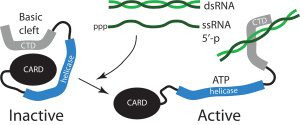

The influenza NS1 protein, which is encoded by viral RNA 8, inhibits the innate and adaptive immune responses by multiple mechanisms. The protein blocks expression of type I IFN and inflammatory cytokines, and interferes with T-cell activation. Viral mutants with a truncated NS1 protein cause less severe disease in mice, pigs, horses, and macaques. Such viral mutants induce higher levels of IFN synthesis, and better T-cell activation, than wild type virus. It has been suggested that viruses with truncated NS1 proteins might be good candidates for infectious, attenuated vaccines against influenza.
The main sensor of influenza virus infection is the cytoplasmic protein known as RIG-I (illustrated). This protein resides in the cytoplasm and senses the presence of viral RNA – either double-stranded RNA (dsRNA) or single-stranded RNA (ssRNA) with a 5′-phosphate. When these RNAs bind RIG-I, a signaling cascade is initiated which culminates in the production of IFN. The IFNs in turn activate the synthesis of nearly a thousand cellular proteins which have antiviral properties.
In order to function in the pathway leading to IFN induction, RIG-I must be ubiquinated near its amino terminus, on what is known as the CARD domain. Attachment of ubiquitin to RIG-I is accomplished by a cellular enzyme called TRIM25. In cells infected with influenza virus, RIG-I is not ubiquinated, and therefore IFN is not produced. The NS1 protein of influenza virus specifically inhibits ubiqutination of RIG-I by TRIM25. It does so by binding to TRIM25 and preventing it from forming multimers. A specific amino acid sequence in NS1, threonine-leucine-glutamic acid-glutamic acid, is involved in binding to TRIM25. A virus in which the two glutamic acid residues are converted to alanine is defective in blocking TRIM25-mediated ubiquitination of RIG-I. Consequently, in cells infected with this mutant virus, IFN is produced and viral replication in suppressed. As expected, the virus is much less virulent in mice than wild type virus.
Other TRIM proteins (the name stands for TRIpartite Motif, a reference to the fact that the proteins have RING, B-box zinc finger, and coiled-coil domains) are also involved in antiviral defense. TRIM19 inhibits the replication of many DNA and RNA viruses, while TRIM5α blocks replication of HIV. TRIM25 is the first protein of this family whose function has been shown to be inhibited by a viral protein, influenza virus NS1. Given the effectiveness of the innate immune response, it is safe to say that viruses exist only because they encode antagonists of this defense system. It seems likely that viral modulators of TRIM19 and TRIM5α await discovery.
Haye, K., Bourmakina, S., Moran, T., Garcia-Sastre, A., & Fernandez-Sesma, A. (2009). The NS1 protein of a human influenza virus inhibits type I interferon production and the induction of antiviral responses in primary human dendritic and respiratory epithelial cells Journal of Virology DOI: 10.1128/JVI.02323-08
Gack, M., Albrecht, R., Urano, T., Inn, K., Huang, I., Carnero, E., Farzan, M., Inoue, S., Jung, J., & GarcÃa-Sastre, A. (2009). Influenza A Virus NS1 Targets the Ubiquitin Ligase TRIM25 to Evade Recognition by the Host Viral RNA Sensor RIG-I Cell Host & Microbe, 5 (5), 439-449 DOI: 10.1016/j.chom.2009.04.006

and this all works the same way in birds ?
fla-A evolves in birds and humans are a dead end,
so why bother about human immunity ?
(if you are a flu-A virus, I mean)
So what happens in a H1N1 reassortment with 7 segments from current swineflu and a segment 8 from old human H1N1? Is that scary?
Yes, birds have an innate immune system, although its interaction with
viruses has been much less well studied. I would not say that
influenza is a dead end infection in humans – it is transmitted among
humans, evolves in humans, and transmitted back to animals. In a dead
end infection, the virus is not transmitted to other humans.
I would not think such a recombinant virus would be so scary – both
the old human H1N1 and the new H1N1 viruses encode an NS1 that binds
TRIM25.
flu-A doesn't go back from humans to birds and it dies in humans when the
next pandemic comes with (segments from) a new virus jumping
from birds to humans.
No transfer to birds of mutations developed in humans.
Except maybe occasional picks, but no sustained transmission of human mutations
in birds.
It doesn't seem to jump back from swine or horses to birds either.
I'm not aware of any such example
There are examples of influenza viruses going back into birds and
other animals from humans. But even if it did not, the virus is
certainly not a dead end infection in humans – it is transmitted
extensively. For example the 1918 H1N1 virus was transmitted among
humans until 1957.
On Fri, Jun 5, 2009 at 5:05 AM,
flu-A doesn't go back from humans to birds and it dies in humans when the
next pandemic comes with (segments from) a new virus jumping
from birds to humans.
No transfer to birds of mutations developed in humans.
Except maybe occasional picks, but no sustained transmission of human mutations
in birds.
It doesn't seem to jump back from swine or horses to birds either.
I'm not aware of any such example
There are examples of influenza viruses going back into birds and
other animals from humans. But even if it did not, the virus is
certainly not a dead end infection in humans – it is transmitted
extensively. For example the 1918 H1N1 virus was transmitted among
humans until 1957.
On Fri, Jun 5, 2009 at 5:05 AM,